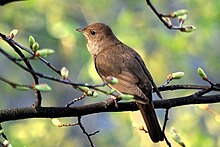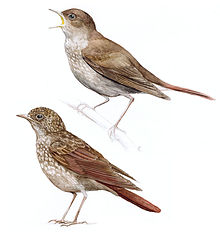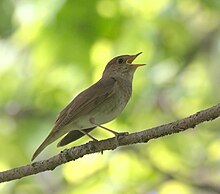Thrush nightingale
| Thrush nightingale | |
|---|---|

| |
| At Uglich, Russia | |
| Scientific classification | |
| Domain: | Eukaryota |
| Kingdom: | Animalia |
| Phylum: | Chordata |
| Class: | Aves |
| Order: | Passeriformes |
| Family: | Muscicapidae |
| Genus: | Luscinia |
| Species: | L. luscinia
|
| Binomial name | |
| Luscinia luscinia (Linnaeus, 1758)
| |

| |
| Distribution of the Luscinia luscinia. Orange: breeding (summer) range, yellow: non-breeding (winter) range. | |
| Synonyms | |
|
Motacilla luscinia Linnaeus, 1758 | |
The thrush nightingale (Luscinia luscinia), also known as the sprosser, is a small passerine bird that was formerly classed as a member of the thrush family Turdidae, but is now more generally considered to be an Old World flycatcher, Muscicapidae.[2] It, and similar small European species, are often called chats.
It is a
The thrush nightingale is similar in size to the European robin. It is plain greyish-brown above and white and greyish-brown below. Its greyer tones, giving a cloudy appearance to the underside, and lack of the common nightingale's obvious rufous tail side patches are the clearest plumage differences from that species. Sexes are similar. It has a similar but more powerful song than that of the nightingale.
Etymology
"Nightingale" is derived from "night", and the Old English galan, "to sing".[3][4] The genus name Luscinia is Latin for the common nightingale.[5]
Description

An adult thrush nightingale is about 16 centimetres (6.3 in) long with a wingspan of approximately 18 centimetres (7.1 in). The head, nape and the whole of the upper parts of the thrush nightingale are dark brown with a slight olive tinge. The colour is much deeper than that of the nightingale and is not at all rufous. The upper tail-coverts are less olivaceous and the tail feathers are dark rufous-brown. The lores and ear-coverts are brownish-black and the chin and throat are pale buff or whitish, mottled with brown, and are paler in colour than the nightingale. The sides of the throat are spotted brown and the pale feathers of the breast have brown central bands giving the breast a mottled appearance. The under tail-coverts are buff, sometimes barred or marked with brown. The wing feathers and wing-coverts are dark brown and less rufous than the nightingale. The beak, legs and feet are brown and the irises are dark brown. The sexes are similar to each other in appearance and the juveniles are darker and more mottled. There is a single moult in July and August at the end of the breeding season.[6]
Voice

The male's ⓘ is loud, with a range of whistles, trills and clicks and includes a flute-like "pioo" with a pure bell-like tone. It is sometimes interrupted by a rasping "dserr" sound and is rather solemn as compared to that of the nightingale. The song does not have that bird's loud whistling crescendo and is quite distinctive. It is also sometimes sung in the bird's winter quarters. The call-note "whit" resembles that of the nightingale but is higher pitched and more abrupt.[6]
Distribution and habitat
The thrush nightingale is a migrant species. It breeds in eastern Europe and the western part of temperate Asia. The northern limit of its summer range extends to
In its breeding range, the thrush nightingale is found in damp deciduous woodland typically with
The bird is a host of the
Behaviour


The thrush nightingale feeds chiefly on the ground taking earthworms, spiders and the adults, larvae and pupae of insects such as beetles, small moths, ants and flies. In the autumn, the berries of currants (Ribes spp.) and elders (Sambucus spp.) are also eaten.[6] Before crossing the Sahara on its migration, thrush nightingales build up their fat reserves. It has been found experimentally that magnetic cues may stimulate the birds to do this. A simulation of the magnetic field found in northern Egypt encouraged birds preparing to migrate from Sweden to further build up their body fat.[9]
The thrush nightingale breeds in damp forests, nesting on the ground, often in the middle of a bed of
Status
References
- . Retrieved 12 November 2021.
- PMID 20656044.
- ^ "Nightingale". Oxford English Dictionary (Online ed.). Oxford University Press. (Subscription or participating institution membership required.)
- ^ "Gale". Oxford English Dictionary (Online ed.). Oxford University Press. (Subscription or participating institution membership required.)
- ISBN 978-1-4081-2501-4.
- ^ a b c d e f Witherby, H. F., ed. (1943). Handbook of British Birds, Volume 2: Warblers to Owls. H. F. and G. Witherby Ltd. pp. 192–193.
- ^ "Thrush Nightingale (Luscinia luscinia)". BirdGuides. Retrieved 2013-09-07.
- S2CID 82191853. Archived from the original(PDF) on 2019-11-09.
- S2CID 895903.
- ^ Butchart, S.; Ekstrom, J. "Thrush Nightingale: Luscinia luscinia". Species factsheet. BirdLife International. Retrieved 2013-09-05.
External links
- Avibase[permanent dead link]
- Thrush nightingale - Species text in The Atlas of Southern African Birds.

